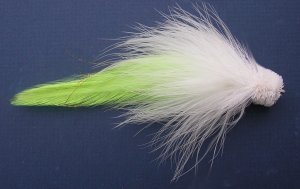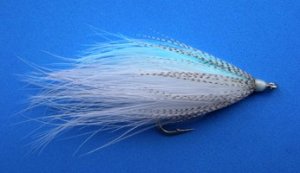Fall is here! The days and nights and water temperature are cooler and the hours of daylight shorter. And the fish are on the move. It's a season that many striper fishermen live for, when the fish are jumpin' and the catchin' is high. When will it end? Who can say? But my best guess is that hot action will continue through October and then slow down considerably by the first week in November. So, if you can get out on the water during the coming weeks, hop to it! The fish are here—and they're waiting for you.
Finding the Fish
In autumn there is a great increase in migratory fish activity, with huge numbers of baby or peanut bunker (juvenile menhaden), silversides, and even occasional schools of herring and smelt, moving along the coast. And naturally enough, there are striped bass and bluefish in hot pursuit, feasting upon the hapless bait fish. Since the stripers are now abandoning their regular shallow-water, inshore feeding areas such as mussel beds and clam flats to follow schools of bait, their movements are less predictable than during the summer months. They are where you find them and where they were yesterday may not be where they are today. Fishermen need to move around a lot, keeping an eye out for fish splashing on the surface or bird activity—terns or gulls or cormorants dipping or diving, revealing the presence of bait pushed to the surface by feeding fish.
The boat fisherman, not limited in mobility to the height of a pair of waders, often has the advantage at this time of year. But that doesn't mean the shore or wading fisherman won't catch fish. Far from it. In many places it's possible to walk or drive along a beach or shoreline and look for bird or bass activity and then—if you hurry— get within casting range. This can be very rewarding fishing and also very frustrating. Rewarding because, to my mind, there's nothing more thrilling than catching fish while wading. Frustrating because the fish are often within casting distance for only a short time and then they're off again, only to return to the shoreline just after you've left to look for another group. Isn't that often the way? If you're not into chasing fish—and there are many who are not so energetic—then the best advice I can give is to simply hang in there where you've found blitzing fish and hope that they return. Meanwhile, if you have patience and continue to fish your fly effectively, the chances are good that you'll catch a few stragglers or passing fish.
The best time to find fish feeding on the surface seems to be from three hours down to low tide and then three hours up into the rise. During this time there's stronger current to concentrate bait and to stir up the appetite of the stripers. If this period occurs in the early morning or late afternoon, so much the better, especially if the day is sunny. On overcast days, it doesn't matter nearly so much; the fish may feed regularly throughout the day.
Flies for Fall

Beastmaster General
I fish only a few flies—or types of flies—in fall. Because I prefer to fish the surface, tops on my list is the Gurgler, either a standard Gurgler with a bucktail tail, or a saddle-wing flat-wing Gurgler tied on a long-shank hook (#1/0), which presents a larger profile. I'll fish this fly whenever the water's surface is relatively calm and not too choppy. Even when no fish are showing, I can be sure of stirring up some action with this commotion fly.
If the water is too choppy to fish a Gurgler I usually opt for a BeastMaster General, all-white or white with a topping of chartreuse, blue, pink or yellow, tied on a #1/0 long shank hook. With its deer hair head, marabou fore-and-aft collaring, and active hackle tail wing, the BMG is designed to float or sink slowly and then "hover" just below the surface. It can also be skittered over the surface or allowed to sink a bit and push water as it moves partly on top and partly just under the surface. If I want to fish deeper for larger fish I add a couple of BB split shot to my leader.

Baby Bunker Soft Hackle Streamer
When fish are feeding on smaller bait fish, they often prefer for a smaller fly. In this case I use a 2-3 inch white Soft Hackle Streamer or Baby Bunker Soft Hackle Streamer (1/0 or 2). If the stripers are gobbling up mouthfuls of bait they may not show much interest in a single fly and, so to increase the odds I fish two flies, attaching a Soft Hackle Streamer to the bend of a small Gurgler or a Soft Hackle Streamer attached to a second one with a 6" length of monofilament. If you try this, be sure to bend the barbs down on each hook since it's not uncommon to catch a fish on each fly.
Fish Deep for Bigger Fish
To me, the best part of fall fishing is that the fish do much of their feeding on the surface or not too far below. You don't have to dredge the bottom with heavy lines and fast-sinking flies. That is, provided you're satisfied with numbers of fish and are less concerned with how big they are. This is because it's usually the smaller, faster fish that feed on the surface. The fatter, slower oldsters can't and often don't compete with these "friskies." So while they may accompany a school of smaller fish, they're often lower in the water column, picking off injured and the maimed bait fish. I happen to be satisfied with fish of any size but there are anglers who prefer larger fish to larger numbers of fish. If you're one of them, then you might want to fish deeper. Toss a large fly into surface-feeding fish but let it sink well below them. Then retrieve it with a slow up-and-down motion, making it look like an injured bait fish.
Stuffed Fish
Because schools of bait being crashed by hungry stripers is the classic image of fall fishing, it's easy to assume that fish will feed any time bait fish. are present. While this may be true in early fall, as time goes by the fish become very much like you and I when we've had a full meal. Once they're full they either stop feeding or at the very least feed less greedily; they're burping not slurping. If you run across these full-fed fish—often found just lolling and lazily swimming about and generally enjoying life—you may find it difficult to interest them. One tactic in this scenario is simply to move on in search of actively feeding fish. But myself, I enjoy this situation. How to tempt the almost untemptable? One way is to tie on a large and long flat-wing Gurgler and fish it very fast across the surface, creating as much commotion as you can. This can drive the fish into attack mode and make them forget that they're full. Another technique is to tie on a large BeastMaster General and skitter it across the surface, again rather quickly, hopping and skipping it with your rod held high and most of your line out of the water. It takes some work, more than some anglers may care to exert, but it's an absolutely deadly method to wake up overstuffed fish.
When the Fish aren't Blitzing
Contrary to the popular notion, autumn striped bass do not always "pod up" or blitz. Sometimes they spread out over a rather large area. This is especially true if there is a lot of boat traffic or if bait fish. are themselves spread out and not balled up. Instead of seeing many fish breaking or showing themselves in a small area you will see a swirl here, a break there, a boil over yonder, or sometimes just a dark patch of nervous water revealing a group of fish. You may even see fins poking up above the surface if the fish are just lolling and not actively feeding. When this is the case, I generally fish a large Gurgler, say a 1/0 flat-wing, and cast over a wide area, working the fly quickly with a lot of "gurgle" to attract attention. If I don't get a strike within five minutes or so I switch to a BeastMaster General and work it across the surface, hopping and skipping with most of my line out of the water. Sometimes a simple change of shape and action are just what is needed to find out if the fish are surface-oriented or not. If I don't get a response on the surface within a few minutes after fishing in an area where I know there are fish, I let the fly sink just below the surface and work it back with a fairly vigorous retrieve, wiggling my rod tip. If I still get no response, I'll fish the fly a bit more slowly, less vigorously, with smoother rod and line movements. And before long, maybe with a few other experiments in between, I'll get a hit. And then another. Once I've established that the fish prefer a fly fished one way over another, I'm into them on a very regular basis. The point I'm making here is that you should experiment with different flies, different levels in the water column, different retrieves, etc. to determine which works best for the time and place you are at. Situations vary widely in the fall and so should your methods.






